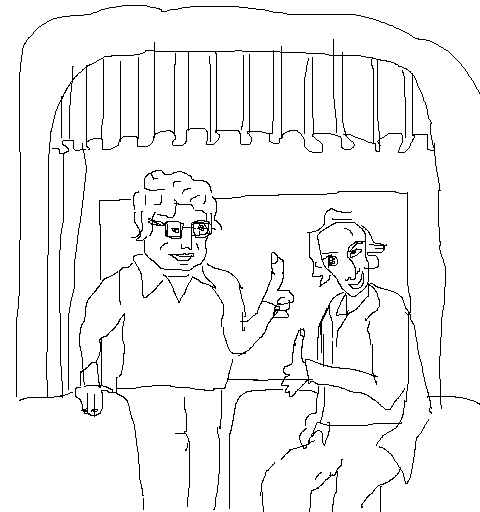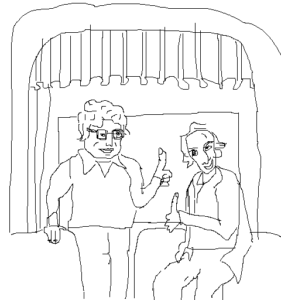
The Genius of Evil
Hello. My name is Todd, and I’m an alcoholic. I guess. I mean, maybe. But what’s this obsession with labels? Everyone always has to be something these days. I’m an alcoholic, I’m a white male. I’m “cisgendered.” I’m this, I’m that. Pfft. Listen: before I consent to adopt the rather insulting appellation with which this little “meet-up” seems determined to label me, perhaps it would be wise if we could arrive, as a group, at a mutually agreeable definition of the term alcoholic itself. Who’s to say, really, what an alcoholic is, or when a particular person’s drinking has crossed over the line, say, from enjoyable nightly ritual to debilitating and catastrophic life-destroying illness?
For the answer I suggest we turn, as I rather often do, to the greatest film critic our nation has ever produced and a personal hero of mine, the late, great Roger Ebert. I’m sure you’re all familiar with the man and his work, whether it be from watching the hit syndicated talk show he shared with the witty, cerebral Gene Siskel (in my opinion Ebert’s only worthy sparring partner), or better still from reading the thousands of wonderful essays he gave us during his four-plus decades’ tenure as chief film critic for the Chicago Sun-Times, each one more insightful and entertaining than the last. Suffice it to say if you’ve ever heard the phrases Two thumbs up or Four stars you have none but the G.O.A.T., Roger Ebert, to thank for that.
But Ebert did not produce only criticism. Oh, no. Roger Ebert was much more than just a “movie hound.” In a tender and searchingly honest confessional posted to the rogerebert.com blog, Ebert described the first stages of his own recovery journey. He regaled us with harrowing tales of his nightmarish struggles with the demons of addiction. And he touched and moved us with insights drawn from his own personal sojourns into the world of twelve-step meetings, surrendering, and finally, bravely overcoming the wine god’s insidious seductions. The essay’s first paragraph contains perhaps the most intriguing definition of the term “alcoholic” I’ve ever encountered. Here’s what Roger Ebert says. He says that if you’re an alcoholic, you take the first drink. The second drink takes you. I’ll repeat it once more so you can really absorb its meaning. Hope you’re all listening. It’s a doozy. You take the first drink. The second drink takes you.
Fascinating, don’t you think?
Now, you may say that this definition is straightforward. And I might be inclined to agree with you. But what, pray tell, does Ebert mean when he uses the term second drink? If he refers only to alcoholic beverages in the strictest sense of the term, well, I’m not sure I really qualify, then. Perhaps I don’t belong in this meeting at all. I’ve never had a problem turning down a second glass of merlot, a second vodka martini. A second Coors. You get the idea.
But if when he says second drink he happens to mean something more along the lines of seventh injection of ketamine-infused crystal meth administered by a towering seven-and-a-half-foot tall lizard man with an electric pink Mohawk and neon green scales on the roof of a mansion on Fire Island owned by a probably fictitious guy named “Larry”; and if as the plunger injects its intoxicating mixture through the point of the needle to the blood in your vein your eyeballs pop clean out of your skull, and your back arches backwards like little Linda Blair’s did in the 1973 horror classic The Exorcist1; and if as all of this transpires you blink your eyes closed momentarily, and when you open them again you’re sitting in the front row of a tiny movie theatre just like the one from Siskel and Ebert, only instead of excerpts from Rambo2 or Silence of the Lambs3 up on the screen, you’re viewing a kind of home movie clips compilation consisting of scenes depicting the manifold sorrows and scant joys of your pathetic young life – all the many mistakes you’ve made, and the people you’ve hurt and the chances you’ve squandered – and the whole thing’s narrated by the Genius of Evil himself, Satan, his voice resounding through the theatre’s interior and reverberating around in your skull till you feel like your head’s about to burst like that poor schmuck at the end of the movie Scanners4, until finally when you think you won’t be able to take any more of it you open your eyes and find yourself in a hospital bed, a gray-haired woman psychiatrist standing above you barking questions like “What seems to be the problem?” and “What are the voices saying now, Todd?”
And if you say “Well, doc, I think I’m starting to get a little confused about which things are happening in the real world and which things are happening in the imaginary worlds inside my own private Idaho5 – I mean, did I say Idaho? Ha, ha! Head, doc! I meant head! And by the way, is this still a movie that we’re in right now, and if so, what’s the genre? And how many stars did Ebert give us? I hope at least three, otherwise it’s a thumbs down. Oh, and doc? I’m pretty sure I’ve broken my pinky toe, so I wonder if you could take a look for me.” And if, when you tell her this, the doctor says “Oh dear,” and grins, the edges of her wolfish smile creeping up the sides of her face until her head looks like it’ll split apart and a demonic entity will shuffle out like a fucking body snatcher from the movie Body Snatchers6; and if she then says: “Oh dear. I’m afraid this whole leg is going to have to go. As to the genre question, this ought to clear things up!” And if producing a cartoonishly large and rusty-looking antique bone saw the doctor proceeds to liberate your right leg from its socket, sawing back and forth through muscle and bone and splattering blood and viscera on the floor, walls and even the ceiling; and if all you can do as this catastrophe unfolds is scream and pray to a God you hope doesn’t exist, because if he did and allowed this kind of thing to happen what kind of a sick, sadistic fuck is the guy, anyway?
And if then you wake up yet again in a whole different hospital, only this time your left wrist has been handcuffed to the bed, and sitting beside you is a lumpy, red-faced policewoman who’s fallen asleep in her cup of hospital vending machine coffee, and you think to yourself as you watch her blow bubbles in the coffee with the tip of her nose, What the hell did you do this time, Todd, you miserable, worthless, pond-scum-swilling moron?
And if it turns out, apparently, that what you did – allegedly! – was chop a hole the size of a cantaloupe melon in your girlfriend Sadie’s sweet, fat face with an ax? And if that’s why you’re here in this meeting today, having been convicted of said murder and sentenced to seven consecutive life sentences in the Fishkill Correctional Facility in Fishkill, New York? Well, fine. If that’s what Ebert means when he says second drink, then okay. You win. I’m a fucking alcoholic.
***
- Which Ebert awarded four stars back when it came out in 1973, by the way, calling it “a cry of pain” and “one of the best movies of its type ever made”
- Three stars (1985)
- Three-and-a-half stars (1991; later upgraded to four for Ebert’s “Great Movies” feature in 2001)
- Just two stars from Ebert in 1981; the man was far too empathic to appreciate the chillier pleasures of early Cronenberg, not awarding a thumbs up to any of the director’s work until The Dead Zone in 1983)
- Three-and-a-half stars (1991)
- Four stars (1994)
